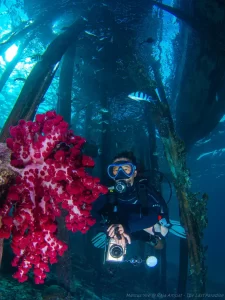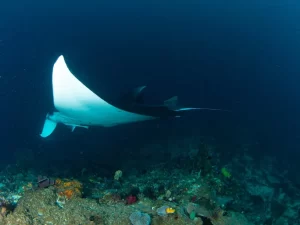
How to Choose the Right Scuba Diving Equipment? A Comprehensive Guide
July 29, 2024
The Benefits of Scuba Diving for Physical and Mental Health
August 1, 2024Marine Life to Watch Out for While Diving
A Guide for Scuba Divers
Diving into the underwater world is an exhilarating experience that brings you face-to-face with incredible marine life. From vibrant coral reefs to majestic sea creatures, the ocean offers a mesmerizing spectacle for scuba divers. However, encountering marine life also requires awareness and respect. In this guide, we’ll explore some of the most fascinating marine species to watch out for while diving and share tips on how to interact with them safely.
1. Colorful Coral Reefs
Coral reefs are the rainforests of the sea, teeming with life and color. While they are a breathtaking sight, it's crucial to avoid touching or standing on the coral. Corals are fragile and can be easily damaged, which can have a lasting impact on the ecosystem. Look for reef-friendly sunscreens and be mindful of your buoyancy to avoid accidental contact.
2. Turtles: Gentle Giants of the Sea
Sea turtles are a diver's favorite. These gentle creatures are often seen grazing on seagrass or swimming gracefully. While it's tempting to get close for a photo, maintaining a respectful distance is essential. Turtles can be easily stressed by human interaction, so admire them from afar and never attempt to touch or ride them.
3. Sharks: Misunderstood Predators
Despite their reputation, sharks are generally not a threat to divers. Species like the reef shark, whale shark, and nurse shark are commonly encountered and are often more curious than dangerous. If you spot a shark, remain calm, avoid sudden movements, and observe from a distance. Remember, these apex predators play a crucial role in maintaining the health of marine ecosystems.
4. Jellyfish: Beautiful but Potentially Harmful
Jellyfish can be mesmerizing with their translucent bodies and flowing tentacles. However, some species can deliver painful stings. Wearing a full-body wetsuit can provide protection against accidental contact. If you encounter a jellyfish, maintain a safe distance and be cautious of their tentacles, which can extend further than they appear.
5. Eels: Shy and Secretive
Moray eels and other eel species often hide in crevices and under rocks. They can be startling to encounter but are generally shy and non-aggressive. If you see an eel, avoid putting your hands into holes or crevices where they might be hiding. Eels usually only bite if they feel threatened or cornered.
6. Manta Rays: Graceful Giants
Manta rays are known for their impressive size and graceful movements. Often spotted at cleaning stations where they get rid of parasites, mantas are curious and may approach divers. However, it’s important to stay still and avoid chasing or touching them. This ensures a safe and respectful encounter for both divers and the rays.
7. Dolphins: Playful Companions
Dolphins are intelligent and playful creatures that sometimes interact with divers. They are often seen in pods and may approach out of curiosity. While it's exciting to see dolphins, avoid trying to swim directly towards them. Let them come to you, and enjoy the encounter without disturbing their natural behavior.
8. Lionfish: Beautiful but Venomous
Lionfish are known for their striking appearance and venomous spines. These fish can deliver a painful sting, so it’s best to admire them from a distance. Lionfish are an invasive species in some areas, and divers are sometimes encouraged to help control their populations under guided and safe conditions.
9. Octopuses: Masters of Disguise
Octopuses are fascinating creatures known for their intelligence and ability to camouflage. They are generally shy and will often retreat if approached. Watching an octopus change color and texture to blend into its surroundings is a highlight for many divers. Always observe these creatures without trying to touch or disturb them.
10. Whales: Majestic Ocean Giants
Encountering a whale while diving is a rare and awe-inspiring experience. These magnificent creatures, including humpback and sperm whales, can sometimes be seen in certain dive locations. Always maintain a respectful distance from whales, as getting too close can be dangerous for both you and the whale.
Tips for Responsible Marine Life Interaction
- Maintain Neutral Buoyancy: This helps you avoid accidentally touching or damaging the reef and marine life.
- Do Not Feed Wildlife: Feeding can disrupt natural behaviors and diets.
- Keep Your Distance: Respect the space of marine creatures to avoid causing stress or harm.
- Do Not Touch: Many marine animals have sensitive skin or can deliver stings and bites.
- Be Aware of Your Surroundings: Always be mindful of where you are and what's around you.
Scuba diving offers a unique opportunity to explore and appreciate the diverse and vibrant world beneath the waves. By understanding and respecting the marine life you encounter, you can ensure a safe and enjoyable diving experience for yourself and help preserve these ecosystems for future generations. Whether you're a novice or an experienced diver, always prioritize safety and environmental conservation on your underwater adventures.













